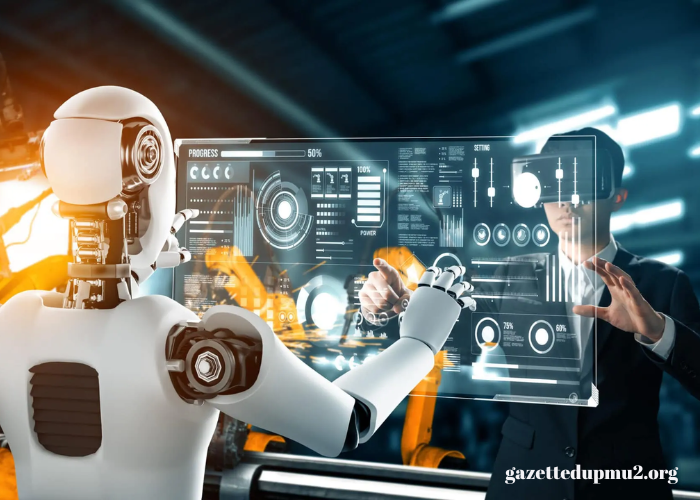In the ever-evolving landscape of technology, artificial intelligence (AI) and robotics stand at the forefront, driving the next wave of innovation and transformation across diverse sectors. The convergence of AI and robotics is not merely enhancing existing systems but is fundamentally reshaping industries, influencing daily life, and redefining the future of automation. This article delves into the remarkable synergy between AI and robotics, exploring their current applications, future potential, and the implications for society.
The Intersection of AI and Robotics
Artificial intelligence, the simulation of human intelligence in machines, and robotics, the engineering and use of robots, are two distinct but interrelated fields. AI enables machines to learn from data, adapt to new inputs, and perform tasks that typically require human intelligence. Robotics involves designing and constructing robots to execute a variety of tasks, often in environments that are hazardous or unfeasible for humans.
When AI and robotics merge, they create intelligent systems capable of performing complex tasks autonomously. This integration leads to the development of robots that not only execute pre-programmed commands but also make decisions based on real-time data, improving efficiency and accuracy in various applications.
Current Applications of AI and Robotics
- Manufacturing and IndustryOne of the most prominent applications of AI and robotics is in manufacturing. Industrial robots, equipped with AI algorithms, are now performing tasks such as welding, painting, and assembly with remarkable precision. These robots are designed to handle repetitive tasks, increasing production speed and reducing human error. AI-powered predictive maintenance systems can anticipate equipment failures before they occur, minimizing downtime and extending the lifespan of machinery.
- HealthcareIn healthcare, robotics and AI are revolutionizing patient care and medical procedures. Surgical robots, guided by AI, offer enhanced dexterity and precision, enabling minimally invasive surgeries with shorter recovery times. AI algorithms analyze medical images to assist in diagnosing conditions more accurately and quickly than traditional methods. Additionally, AI-powered robots are being developed for tasks such as elder care and rehabilitation, providing support and companionship to patients.
- AgricultureThe agricultural sector is experiencing a technological transformation with the integration of AI and robotics. Autonomous drones equipped with AI are used for monitoring crop health, assessing soil conditions, and optimizing irrigation. Robotic systems handle tasks such as planting, harvesting, and weeding with increased efficiency, reducing the need for manual labor and improving crop yields.
- TransportationAI and robotics are making significant strides in transportation, particularly in the realm of autonomous vehicles. Self-driving cars utilize AI to process data from sensors, cameras, and radars to navigate roads safely and efficiently. Robotics also play a role in logistics, with autonomous robots handling tasks in warehouses, optimizing inventory management, and streamlining supply chain operations.
- Service IndustryIn the service industry, AI-powered robots are transforming customer interactions and support. From chatbots providing instant responses to customer inquiries to robotic assistants in hospitality settings, these systems enhance customer experiences and operational efficiency. AI algorithms enable these robots to understand and respond to human emotions and preferences, offering a more personalized service.
The Future Potential of AI and Robotics
As technology continues to advance, the potential applications of AI and robotics are expanding rapidly. Several key trends and developments are likely to shape the future of automation:
- Enhanced Human-Robot CollaborationThe future of robotics will see an increase in collaborative robots, or cobots, designed to work alongside humans rather than replacing them. These robots will be equipped with advanced sensors and AI algorithms to safely interact with human workers, enhancing productivity and safety in various work environments. The collaboration between humans and robots will enable the completion of complex tasks that require both human creativity and robotic precision.
- Advancements in AI AlgorithmsAI algorithms are continually evolving, with improvements in machine learning, deep learning, and natural language processing. These advancements will enable robots to perform more complex tasks, understand context better, and exhibit more sophisticated decision-making capabilities. The development of general AI, which aims to replicate human cognitive abilities, could further enhance the capabilities of robots and their applications.
- Ethical and Regulatory ConsiderationsAs AI and robotics become more integrated into society, ethical and regulatory considerations will play a crucial role. Issues such as data privacy, algorithmic bias, and the impact of automation on employment will need to be addressed. Developing frameworks for responsible AI use, ensuring transparency in decision-making processes, and establishing guidelines for the ethical deployment of robots will be essential for fostering public trust and acceptance.
- Personalized RoboticsThe future may see the rise of personalized robots designed to cater to individual needs and preferences. From home assistants tailored to specific household requirements to healthcare robots customized for individual patient care, personalization will enhance the effectiveness and relevance of robotic solutions. AI algorithms will enable these robots to adapt and learn from user interactions, providing a more intuitive and responsive experience.
- Integration with Emerging TechnologiesAI and robotics will increasingly integrate with other emerging technologies, such as the Internet of Things (IoT) and 5G. The IoT will enable robots to connect and communicate with various smart devices, creating interconnected systems that enhance automation and efficiency. 5G technology will provide the high-speed connectivity needed for real-time data processing and communication, further advancing the capabilities of AI-powered robots.
Implications for Society
The advancements in AI and robotics carry significant implications for society. On one hand, these technologies offer the potential for increased productivity, improved quality of life, and new opportunities for innovation. On the other hand, they raise concerns about job displacement, ethical challenges, and the need for equitable access to technology.
- Economic ImpactAutomation driven by AI and robotics has the potential to boost economic growth by enhancing productivity and creating new markets. However, it may also lead to job displacement in certain sectors. Policymakers and organizations will need to address these challenges by investing in reskilling and upskilling programs to prepare the workforce for the evolving job landscape.
- Quality of LifeAI and robotics have the potential to improve quality of life by offering enhanced healthcare, personalized services, and increased convenience. From robotic companions for the elderly to advanced medical treatments, these technologies can address various aspects of human well-being. Ensuring that the benefits of automation are accessible to all will be crucial in maximizing its positive impact.
- Ethical ConsiderationsThe ethical implications of AI and robotics are a significant area of concern. Ensuring that AI systems are designed and deployed with fairness, transparency, and accountability will be essential. Engaging in discussions about the ethical use of technology and establishing guidelines for responsible development will help mitigate potential risks and promote positive outcomes.
Conclusion
AI and robotics are pioneering the future of automation, driving innovation across diverse sectors and reshaping the way we live and work. As these technologies continue to advance, they offer exciting possibilities for enhancing productivity, improving quality of life, and creating new opportunities. However, addressing the associated challenges and ethical considerations will be crucial in ensuring that the benefits of AI and robotics are realized in a responsible and equitable manner. The journey ahead promises to be transformative, as AI and robotics pave the way for a new era of automation and technological advancement.




